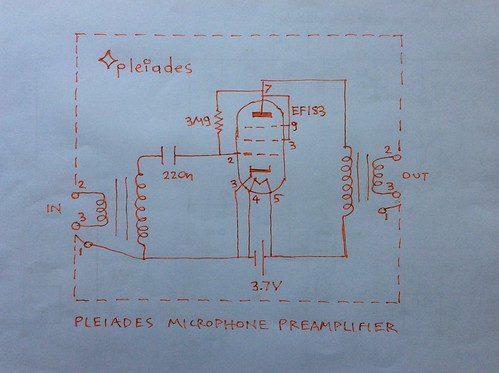This is on an one electronic valve or electron tube microphone booster preamplifier powered by just one AA size 3.7V battery including anode. In particular on construction considerations of the Pleiades V6 ultra low noise microphone head amplifier. Everything including the battery and electron tube or electronic valve to be inside an elegant small size enclosure.
Before making the prototype a hardwired version may be made but it will be in an already existing bigger box.
It was dreamed that a rectangular aluminum prototype caused setting up details in a studio environment. The microphone to be connected was the Sennheiser MD441 U3. Everything has to be ready with minimum connections or delay. The microphone connected to the low noise Pleiades V6 booster amplifier and the output from the Pleiades V6 feeding everything else. Fletcher Munson, voice effort curves can be internaly selected by a switch.
The Hammond octagon orange colored aluminum diecast enclosure is a very promising option.
It is slightly bigger than a rectangular box.
But the main advantage is symmetry and the convenience of 8 faces available for each internally mounted component of the microphone booster amplifier. No sharp edges. Another advantage is that the connections from battery holder to output transformer to electron tube will be very short. The only problem so far is that the inside of the enclosure is not painted. It would look so much better at least as good as the outside. Why orange? A beautiful color reminding the calmness of sunset.
How can each one of the 8 faces be used?
In reference to the Pleiades V6 schematic:

Rotating clockwise...
Side (or face) 1 supporting the Bulgin AA battery holder, to be housing a 3.7V li-ion battery. A 700mAh charge should give many hours with the Nuvistor 7586 electron tube consuming 100mA. The EF183 should consume double power as the underheated heaters might be at 200mA. A fuse holder should be in series with the battery holder.
Side 2 supporting the output transformer ring core. So connection of the thin Vb wire will be right next to the battery holder + terminal.
Side 3 an electron tube 9 pin base. So that the other thin wire of the output transformer is connected right next to it. The unusual concept here is that the pins will be used as stand off pins for soldering the Nuvistor base. So the Nuvistor electron tube can be inside the box. A 9 pin electron tube can be connected externally. But in any way the noval socket will generally serve as communication interface to the outside world. For example measuring potentials or with 9 pin adapters almost any electron tube can be connected, including EF14, ECC88, 6SK7 etc. So very low anode voltage performance with Pleiades bias of almost any electron tube can be accessed fairly quickly.
Side 4 supporting the ring core of the input transformer. Again this is next to the electron tube so that the thin hi Z wires can be made short.
Side 5 the mic input Neutrik female XLR connected to the 25Ω primary winding. Great for the Grampian DP4/L microphone etc.
Side 6 the mic input Neutrik female XLR connected to the 200Ω primary winding. Great for the Sennheiser MD211, MD441, Electro-Voice RE15, Shure Unidyne III, Beyer M55, Shaub Lorentz SM200 microphones etc.
Side 7 the circular Bulgin or Velleman recessed aluminum, or inox push button. It will only control power to heaters for soft on or off. Anode voltage is always supplied.
Side 8 the boosted mic output Neutrik male XLR connected to the output transformer secondary.
Note, input, output is balanced. The Pleiades bias resitor may be variable for adjusting bandwidth. The output impedance using the EF183 and a 10:1 output trasformer is approx 300Ω. It may be higher using the Nuvistor 7586. No such measurement has been made yet.
This may be possibly the first true portable electron tube amplifier operating with just an AA size battery for many hours and all components housed inside a small elegant box. And ultra low noise due to low anode voltage, absence of secondary emission effects, low cathode temperature therefore low anode internal resistance thermal noise.
There should also be a switch called FMVE, ie Flethcer Munson, voice effort compensation for flat frequecy response from producer's brain to listener's brain. It would connect a Pleiades (R,L) gentle slope low cut filter across each primary winding in turn.
Further reading:
The Pleiades Bias - euroelectron
A Study of Noise in Vacuum Tube And Attached Circuits - F. B. Llewellyn - Proc. I.R.E, Vol. 18, Number 2, February 1930
Operating Features of the Audion - E. H. Armstrong
Flat frequency response from producer's brain to listener's brain, Sound Picture Recording and Reproducing Characteristics - D. P. Lowe, K. F. Morgan - JSMPE
No comments:
Post a Comment